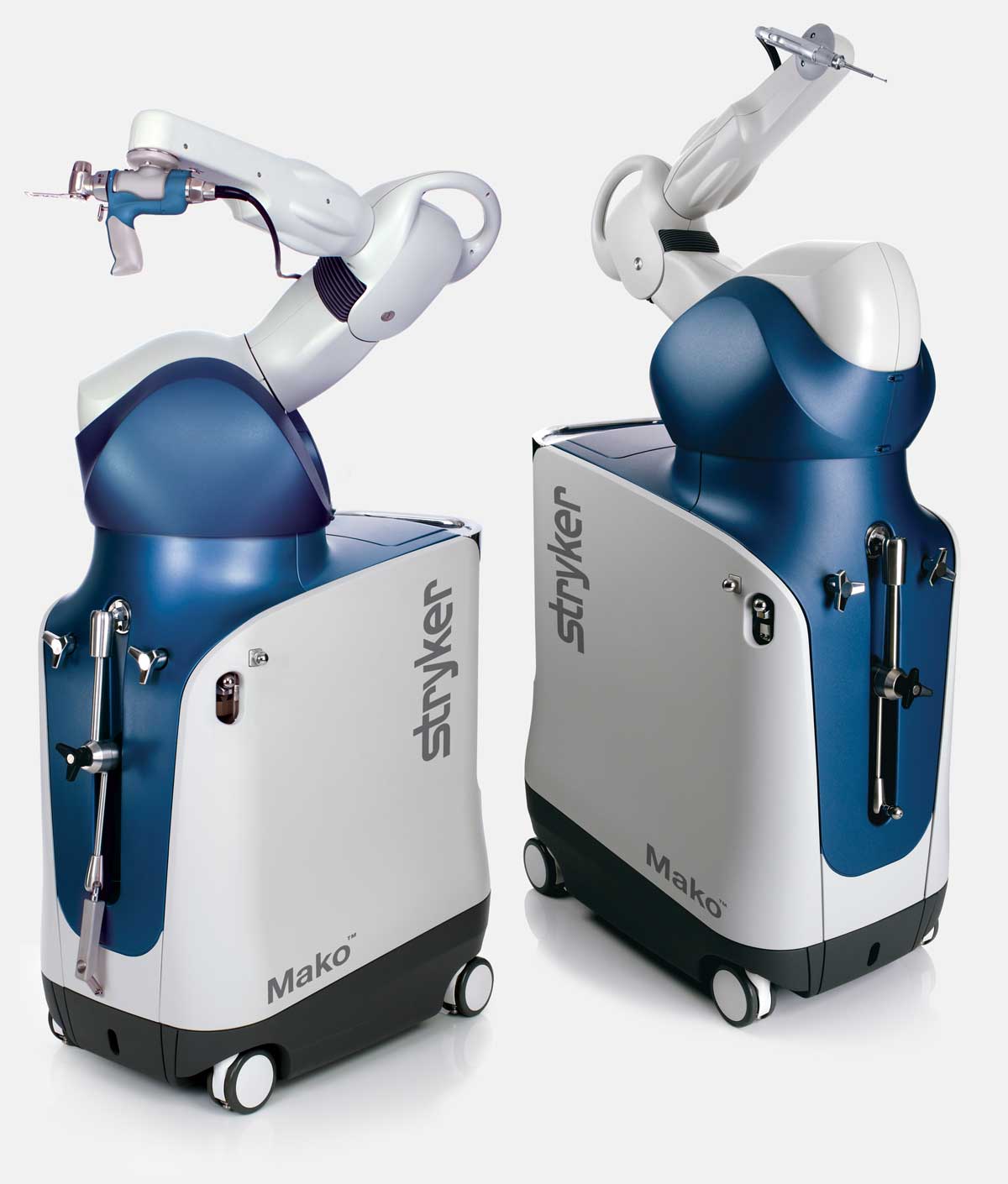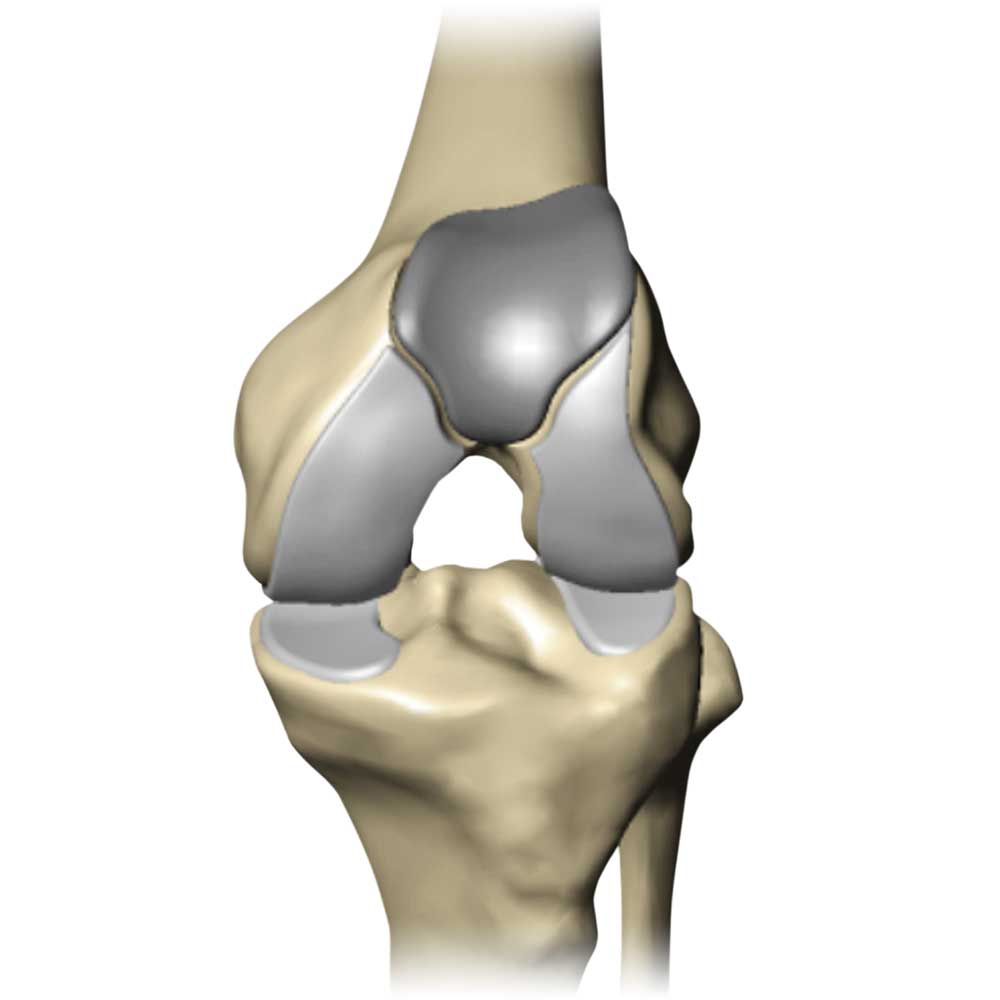Knee Replacement Surgery
Diagnosis and treatment of knee pain
Each patient is unique, and can experience knee pain for different reasons. It’s important to talk to us about the reason for your knee pain so you can understand the treatment options available to you. Arthritis, one possible reason for knee pain, can affect one or more of the three compartments of the knee. Take a look at the different areas where arthritis can affect the knee joint:
- the inside of the knee, or medial compartment
- the outside of the knee, or lateral compartment
- the top of the knee is also known as the kneecap, or patella compartment
Pain from arthritis and joint degeneration can be constant or come and go, occur with movement or after a period of rest, or be located in one spot or many parts of the body. If you haven’t experienced adequate relief with medication and other conservative treatments, total knee replacement may provide you with relief from your arthritis.


Robotic Assisted Surgery
About Mako Robotic-Arm Assisted Technology
Mako Robotic-Arm Assisted Total Knee replacement is a treatment option for adults living with mid to late-stage osteoarthritis (OA) of the knee. Mako provides you with a personalized surgical plan based on your unique anatomy. First, a CT scan of the diseased knee joint is taken. This CT scan is uploaded into the Mako System software, where a 3D model of your knee is created. This 3D model is used to pre-plan and assist your surgeon in performing your total knee replacement.
In the operating room, your surgeon follows your personalized surgical plan while preparing the bone for the Triathlon Total Knee implant. With over a decade of clinical history, Triathlon knee replacements are different than traditional knee replacements because they are designed to work with the body to promote natural-like circular motion.1-4
The surgeon guides the robotic-arm to remove diseased bone and cartilage within the pre-defined area and the Mako System helps the surgeon stay within the planned boundaries that were defined when the personalized pre-operative plan was created. In a laboratory study, Mako Technology demonstrated accurate placement of implants to a personalized surgical plan.5
It’s important to understand that the surgery is performed by an orthopaedic surgeon, who guides the robotic-arm during the surgery to position the implant in the knee joint. The robotic-arm does not perform surgery, make decisions on its own, or move without the surgeon guiding the robotic-arm. The Mako System also allows your surgeon to make adjustments to your plan during surgery as needed.
Partial Knee Replacement
A Mako Robotic-Arm Assisted Surgery
Partial Knee Replacement is a surgical procedure that helps relieve arthritis in one or two of the three compartments of the knee. With Partial Knee Replacement, only the damaged area of the knee joint is replaced, which may help to minimize trauma to healthy bone and tissue.
Stryker has worked with surgeons to develop innovative products to be utilized in Partial Knee Replacement. Stryker’s robotic-arm assisted technology can be used for partial knee replacement, which is a procedure designed to relieve the pain caused by joint degeneration due to osteoarthritis (OA). By selectively targeting the part of your knee damaged by OA, your surgeon can replace the diseased part of your knee while helping to spare the healthy bone and ligaments surrounding it.
There are three types of Partial Knee Replacements:
1 Unicondylar
Unicondylar Knee Replacement is a procedure that replaces only the single affected compartment of the knee, either the medial or lateral compartment.
2 Patellofemoral

Patellofemoral Knee Replacement is a procedure that replaces the worn patella (the kneecap) and the trochlea (the groove at the end of the thigh bone).
3 Bicompartmental

Bicompartmental Knee Replacement is a procedure that replaces two compartments of the knee, the medial and patellofemoral compartments.
Frequently Asked Questions
If you have additional questions, please call our office at:
(817) 335-4316
We understand that making sure your total knee replacement is covered by health insurance is important to you. Check with your health insurance provider to verify your specific coverage.
The first Mako procedure was a partial knee replacement performed in June of 2006. Since that time, over 83,000 Mako hip and knee replacement procedures have been performed around the world.
No, the robotic-arm doesn't perform surgery, nor can it make decisions on its own or move without the surgeon guiding it.
Individual results vary and not all patients will have the same postoperative recovery and activity level. The lifetime of a knee replacement is not infinite and varies with each individual.
IMPORTANT INFORMATION
Knee replacements
General indications: Total knee replacement is intended for use in individuals with joint disease resulting from degenerative, rheumatoid and post-traumatic arthritis, and for moderate deformity of the knee.
Contraindications: Knee replacement surgery is not appropriate for patients with certain types of infections, any mental or neuromuscular disorder which would create an unacceptable risk of prosthesis instability, prosthesis fixation failure or complications in postoperative care, compromised bone stock, skeletal immaturity, or severe instability of the knee.
As with any surgery, knee replacement surgery has serious risks which include, but are not limited to, peripheral neuropathies (nerve damage), circulatory compromise (including deep vein thrombosis (blood clots in the legs)), genitourinary disorders (including kidney failure), gastrointestinal disorders (including paralytic ileus (loss of intestinal digestive movement)), vascular disorders (including thrombus (blood clots), blood loss, or changes in blood pressure or heart rhythm), bronchopulmonary disorders (including emboli, stroke or pneumonia), heart attack, and death.
Implant related risks which may lead to a revision include dislocation, loosening, fracture, nerve damage, heterotopic bone formation (abnormal bone growth in tissue), wear of the implant, metal sensitivity, soft tissue imbalance, osteolysis (localized progressive bone loss), and reaction to particle debris. Knee implants may not provide the same feel or performance characteristics experienced with a normal healthy joint.
The information presented is for educational purposes only. Speak to your doctor to decide if joint replacement surgery is right for you. Individual results vary and not all patients will receive the same postoperative activity level. The lifetime of a joint replacement is not infinite and varies with each individual. Your doctor will help counsel you about how to best maintain your activities in order to potentially prolong the lifetime of the device. Such strategies include not engaging in high-impact activities, such as running, as well as maintaining a healthy weight. Ask your doctor if the Triathlon knee is right for you.
Stryker Corporation or its other divisions or other corporate affiliated entities own, use or have applied for the following trademarks or service marks: Mako, Stryker, Triathlon. All other trademarks are trademarks of their respected owners or holders.
References
- Mistry J, Elmallah R, Chughtai M, Oktem M, Harwin S, Mont M. Long-Term Survivorship and Clinical Outcomes of a Single Radius Total Knee Arthroplasty. International XXVIII.
- Designed to maintain collateral ligament stability throughout the range of motion. Stryker-Initiated Dynamic Computer Simulations of Passive ROM and Oxford Rig Test, Stephen Piazza, 2003.
- Wang H, Simpson KJ, Ferrara MS, Chamnongkich S, Kinsey T, Mahoney, OM. Biomechanical differences exhibited during sit-to-stand between total knee arthroplasty designs of varying radii. J Arthroplasty. 2006;21(8):1193-1199.
- Gómez-Barrena E, Fernandez-García C, Fernandez- Bravo A, Cutillas-Ruiz R, Bermejo-Fernandez G. Functional performance with a single-radius femoral design total knee arthroplasty. Clin Ortho Relates Res. 2010;468(5):1214-1220.
- Hampp E. et al. Robotic-Arm Assisted Total Knee Arthroplasty Demonstrated Greater Accuracy to Plan Compared to Manual Technique. Orthopaedic Research Society 2017 Annual Meeting, San Diego, CA. Poster No. 2412. March 20-22, 2017.
MKOHMT-PE-3_Rev-1_13841
Copyright © 2017 Stryker Corporation
Used with permission by Texas Health Care Fort Worth Bone and Joint Clinic

